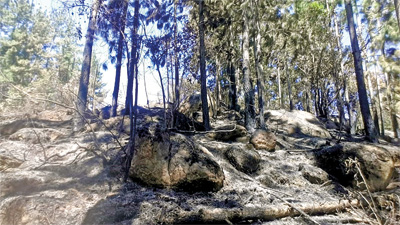News
Blowing in the wind: Our own manmade forest fires fanned by drought
The drought has set in around Sri Lanka and, with it, forest fires have started. Despite repeated pleas, advice and warnings by the authorities, the blazes are all manmade.

Around four acres of pine cultivation were lost along the Rakwana-Deniyaya road at Wangu Dahaya
Fires in forests are not uncommon here. The number reported annually ranges from 50 to 200 depending on prevailing weather, said a paper published in 2001 by K P Ariyadasa, a former Conservator General of Forests. With climate change, however, droughts in Sri Lanka have grown longer and more intense. The stakes are higher but preparedness remains static.
This week, around four acres of pine cultivation were lost on the Rakwana-Deniyaya road at Wangu Dahaya. The fire didn’t spread only because the Forest Department, to whom the plantation belongs, quickly mobilised along with several Grama Niladharis (GN), police and villagers to put it out.
As in most cases where the military does not get involved, the teams used sticks and branches to beat down the flames whilst also filling bottles with water from a pipeline that crossed the forest, said Dharmapala Kotuwatta, the 47-year-old GN for Rakwana South. Nobody had safety equipment and many wore rubber slippers.
Mr Kotuwatta wasn’t fazed by the fire. He said they tended to happen around this time of year. But Jayantha Wijesingha, Convener at Rainforest Protectors of Sri Lanka, says it’s not quite the same as before.
“Climate change definitely has an impact now,” he said. “It was hard to see months without rain in Rakwana a decade ago. But, now, there are months, at times four months straight, without any rain.”
“It has only been about two weeks into the drought and already a water crisis is looming,” he cautioned. “The heat is severe. Streams have partly dried up and water retention is very low, worsening the dry conditions and contributing towards fires.”
However many forest fires there are each year, they are inevitably caused by man, confirmed W A C Weragoda, Conservator General of Forests. “They are not natural phenomena,” he said. “Someone or the other does it, despite the awareness programmes we conduct each year. They set the forest on fire and we cannot catch the culprit.”
This week, the fire broke out immediately after a group of people engaging in Thai Pongal festivities stopped there to consume liquor and have a meal. “Sometimes, cigarette butts are to blame,” said Mr Weragoda. “Fires are lit for the purpose of chena cultivation or to create grasslands for cattle or to free up more land for encroachment. And some people just do it for fun.”
“Typically, the general public and farmers set fire to mountains so they can encroach onto lands belonging to the Land Reform Commission (LRC) or Forest Department or Wildlife Conservation Department,” said Mr Wijesingha. “Others might want to hunt porcupine or pangolin and if you burn down the trees their burrows can easily be seen. But sheer ignorance is also a cause. Villagers might clear their land and set the debris on fire and it then spreads to adjoining lands and mountains with the wind.”
It is also known that when you set fire to the mountains, the rains that follow cause sand to be deposited in streams and rivers–thereby proving a boon to sand collectors and miners, he said.
In 2016, vast areas of forest were destroyed in the Adam’s Peak forest reserve. It was later found that some climbers had lit a fire to cook noodles on their way up from the Kuruwita side and didn’t put it out properly before going on their way. Helped by dry conditions, the blaze that broke out in Rathangolla area of the Walawe valley quickly spread to the Balangoda section of the reserve.
In August last year, fires on the Ella Rock attracted global attention in view of it being a tourist hotspot. It took villagers, the air force army, police and local officials more than 20 hours to extinguish. At the time, a spokesman for the District Disaster Management Coordinating Unit (DDMCU) in Badulla said it was an annual occurrence and that this was the third blaze reported for that month.
In 2018, the air force was dispatched to put out a fire in the Maragala mountain area of Moneragala. Hundreds of acres were burned. Again, dry conditions were prevalent with the Met Department having issued an “extreme heat” advisory for several around the country.
Research shows that Sri Lankan authorities have knowledge of vulnerable areas and have set up village committees as well as carried out awareness over the years. But there was no evidence of additional preparedness prompted by climate change. There is also no coordinated fire prevention or fighting plan that is not defined or limited by institutional and district boundaries.
“Preparedness is very low,” Mr Wijesingha said. “We need to have a clear attention to this issue. The drought will extend to April, at a minimum, and if the rains don’t come after that, it will be till June, July, even August.”
Areas prone to fires typically have village committees that help douse the flames. But the authorities say that human resources are the biggest challenge to effective fire-fighting. Mr Weragoda said even they needed more officers on the ground.
And the respective DDMCUs keep complaining that their role here is deeply misunderstood. Not only do they have a mere handful of officers per district office (just four to cover 575 GN divisions in all of Ratnapura, for instance) their role is limited to coordinating assistance, particularly of the military.
But their reluctance to call for air force intervention, on account of the cost, is particularly irksome to environmentalists. “The DMC also does not have coordination with people on the ground,” said Mr Wijesingha. “It should not be that environmental organisations get information before the DMC about a forest fire.”

